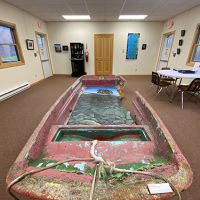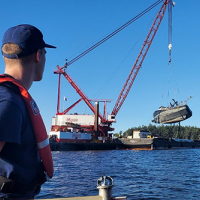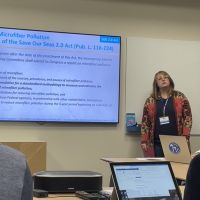In this week's edition, OR&R provides response support for 22 incidents in February; a sunken crane-topped barge is removed from the Providence River; and 15 years later, we reflect on the Deepwater Horizon oil spill, its response efforts and tools, and the advancements in science that better enable teams to support future events.
OR&R Weekly Report
The Office of Response and Restoration publishes this weekly round-up of news and information of interest to our partners, stakeholders, and team members. Click to subscribe
April 2025
March 2025
In this week's edition, OR&R and partners release new resources on uncrewed aircraft systems guidance for oil spill and disaster response, assessment, and data management; OR&R recaps its support for 17 incidents in January, NOAA supports planning for U.S. Coast Guard Hurricane Exercise (HUREX), and more.
January 2025
In this week's edition, OR&R and the U.S. Coast Guard expand an oil spill planning tool to Lake Erie, two restoration plans and environmental assessments for the Oahu Sugar Site are released, and more.
In this week's edition, learn how OR&R and partners recovered $40 million from polluters in 2024, register for an upcoming webinar exploring preventative and regulatory efforts to reduce plastic usage in island communities, meet an OR&R employee and two valued partners and colleagues recently honored with National Ocean Service awards, and more.
December 2024
In this week's edition, check out eleven projects recently announced to receive funding to remove derelict traps from coastal waters, read about novel tools, methods, and approaches to Natural Resource Damage Assessment (NRDA) featured in SETAC Globe, and learn about NOAA scientists sharing rxperiences and expertise with Florida student researchers.
In this week's edition, OR&R supports the Philippine Coast Guard with oil spill response training, the web-based mapping application ERMA® gets an update, the Disaster Response Center hosts NOAA's Office of the National Marine Sanctuaries leadership team, and more.
November 2024
In this week's edition, OR&R participates in a Republic of Korea - U.S. Joint Maritime Oil Spill Response workshop, the NOAA Southeast Region participates in the fall Texas trustee summit on Natural Resource Damage Assessments, regulatory updates for 2024 are released in CAMEO Data Manager and Tier2 Submit, and more.
In this week's edition, check out newly released disaster aid resources for Louisiana communities, learn about assessment and restoration science promoted at the Society of Environmental Toxicology and Chemistry North America annual meeting, and meet four new interns joining OR&R to support natural resource damage assessment and restoration.
In this week's edition, a new marine debris exhibit, made possible with funding from the NOAA Marine Debris Program, debuts at Isle Royale National Park in Michigan.
October 2024
In this week's edition, OR&R hosts an intellectual exchange with a London-based spill response nonprofit.
October 2023
In this week's edition, the NOAA Marine Debris Program in collaboration with the NOAA Office of National Marine Sanctuaries releases a new report on marine debris in Monterey Bay National Marine Sanctuary, the U.S. Coast Guard releases a video on a NOAA partnership to advance spill response, and more.
In this week's edition, OR&R is recognized for coastal resilience with an environmental award, the NOAA Marine Debris Program releases the Puerto Rico Strategic Plan to reduce aquatic debris and NOAA joins the Seattle Aquarium for a microplastics and marine debris workshop.
In this week's edition, OR&R shares the science of oil spill response with science teachers, OR&R trains New England region emergency responders in the science of oil spills, and OR&R accompanies the U.S. Coast Guard for an offshore wind spill exercise in the Northeast.
In this week's edition, OR&R shares marine debris expertise with an international working group working to develop a microplastics monitoring framework in the Great Lakes and convenes with Indo-Pacific partner nations for an oil spill response workshop.
 An official website of the United States government.
An official website of the United States government. 













